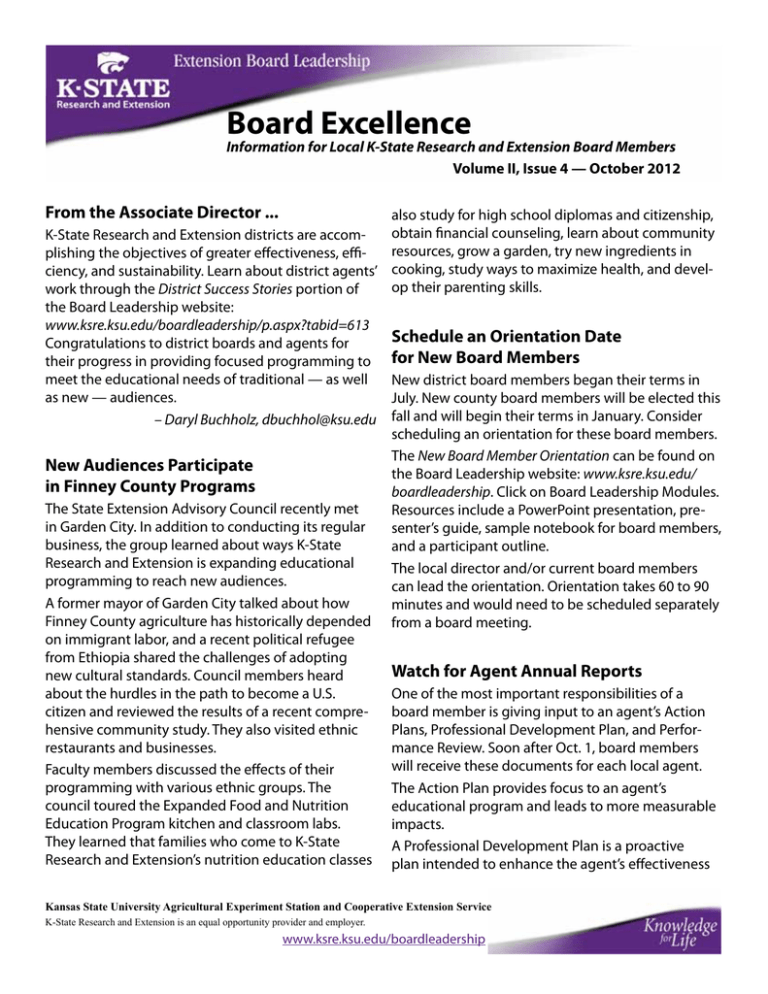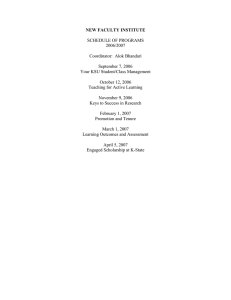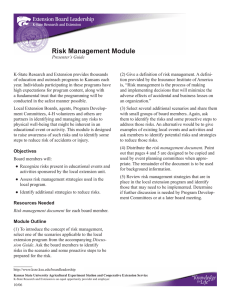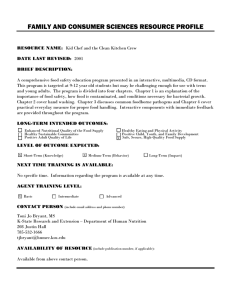Board Excellence From the Associate Director ...
advertisement

Board Excellence Information for Local K-State Research and Extension Board Members Volume II, Issue 4 — October 2012 From the Associate Director ... also study for high school diplomas and citizenship, obtain financial counseling, learn about community K-State Research and Extension districts are accomresources, grow a garden, try new ingredients in plishing the objectives of greater effectiveness, efficiency, and sustainability. Learn about district agents’ cooking, study ways to maximize health, and develop their parenting skills. work through the District Success Stories portion of the Board Leadership website: www.ksre.ksu.edu/boardleadership/p.aspx?tabid=613 Schedule an Orientation Date Congratulations to district boards and agents for their progress in providing focused programming to for New Board Members meet the educational needs of traditional — as well New district board members began their terms in as new — audiences. July. New county board members will be elected this – Daryl Buchholz, dbuchhol@ksu.edu fall and will begin their terms in January. Consider scheduling an orientation for these board members. The New Board Member Orientation can be found on New Audiences Participate the Board Leadership website: www.ksre.ksu.edu/ in Finney County Programs boardleadership. Click on Board Leadership Modules. The State Extension Advisory Council recently met Resources include a PowerPoint presentation, prein Garden City. In addition to conducting its regular senter’s guide, sample notebook for board members, business, the group learned about ways K-State and a participant outline. Research and Extension is expanding educational The local director and/or current board members programming to reach new audiences. can lead the orientation. Orientation takes 60 to 90 A former mayor of Garden City talked about how minutes and would need to be scheduled separately Finney County agriculture has historically depended from a board meeting. on immigrant labor, and a recent political refugee from Ethiopia shared the challenges of adopting Watch for Agent Annual Reports new cultural standards. Council members heard about the hurdles in the path to become a U.S. One of the most important responsibilities of a citizen and reviewed the results of a recent compreboard member is giving input to an agent’s Action hensive community study. They also visited ethnic Plans, Professional Development Plan, and Perforrestaurants and businesses. mance Review. Soon after Oct. 1, board members will receive these documents for each local agent. Faculty members discussed the effects of their programming with various ethnic groups. The The Action Plan provides focus to an agent’s council toured the Expanded Food and Nutrition educational program and leads to more measurable Education Program kitchen and classroom labs. impacts. They learned that families who come to K-State A Professional Development Plan is a proactive Research and Extension’s nutrition education classes plan intended to enhance the agent’s effectiveness Kansas State University Agricultural Experiment Station and Cooperative Extension Service K-State Research and Extension is an equal opportunity provider and employer. www.ksre.ksu.edu/boardleadership through participation in professional association meetings, workshops, graduate study, or in-service opportunities. In the Performance Review, agents provide specific examples of their efforts in five categories: program development, professionalism, volunteer development, interpersonal skills, and management skills. After receiving the documents, board members review them, respond with comments, and submit them to the appropriate administrator. Feedback is shared with the agent during the annual performance review. Performance review information is confidential and not to be discussed with anyone other than the agent, board members, and the appropriate administrator. For more information, visit: Agent Performance Review Module. Self-Assessment Assists in Developing Leadership Excellence in the local extension program is a reflection of the leadership and commitment of each board member. The Excellence in Board Leadership assessment is a tool to guide boards in leadership and development. At the beginning of the year, boards set goals based on best practices to guide their work. Throughout the year boards review their goals, complete the selfassessment, and submit the document to the area director by the following Jan. 1. Boards that achieve a standard for 2012 will be recognized for their accomplishments at the January 2013 Partnership Meetings. The self-assessment is on the Board Leadership website at: www.ksre.ksu.edu/boardleadership. Upcoming Surveys Help Prioritize Local and Statewide Programming In the next few months local boards and program development committees will be asked to provide input into local and statewide programming. The Program Prioritization Project will involve program development committee members in identifying individuals — including those from nontraditional audiences — to participate in a statewide survey regarding topics of concern to local communities. The project will help determine the relative importance Kansans place on program focus teams’ current and potential program concepts. The program prioritization task force, a group made up of representatives from each program focus team, leads the project, which will be completed by spring 2013. Program development committees, agents, and program focus teams will be able to use the information when developing their 2013–2014 action plans. Focus on Outcomes Currently about 13 percent of Kansans are age 65 or older, and by 2030, 20.2 percent will be 65 or older. The aging of the state’s population will significantly affect society. K-State Research and Extension is making a difference by empowering individuals and families to adapt to changes associated with aging. Outcomes reported from community conferences for aging issues include the following: • 67 percent shared end-of-life wishes with family; • 48 percent increased communication regarding difficult issues; • 47 percent increased physical activity; • 28 percent indicated a better understanding of aging; and • 23 percent established an open dialogue with a health-care provider. Volume II, Issue 4 – October 2012 Click here for a link to the weekly K-State Research and Extension Tuesday Letter.


